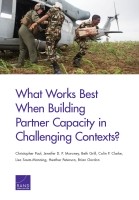| 来源类型 | Research Reports
|
| 规范类型 | 报告
|
| ISBN | 9780833088710
|
| 来源ID | RR-937-OSD
|
| What Works Best When Building Partner Capacity in Challenging Contexts? |
| Christopher Paul; Jennifer D. P. Moroney; Beth Grill; Colin P. Clarke; Lisa Saum-Manning; Heather Peterson; Brian J. Gordon
|
| 发表日期 | 2015
|
| 出版年 | 2015
|
| 页码 | 78
|
| 语种 | 英语
|
| 结论 |
Many Challenges Stem from U.S. Policy or Practice- Such issues as changes in funding and other support and which specific entities may receive support or training can affect the overall success of building partner capacity (BPC) efforts.
- While a robust partner can usually fill in any gaps in U.S. processes or support, a partner that already faces challenges may not be able to do so.
The Partner Nation (PN) Itself Must Be Willing to Engage Fully- The lack of willingness to support and participate in BPC of PN personnel at any level (head of state or ministry, service or command, or individual trainees) can disrupt BPC efforts.
- Such willingness is often contingent on a shared understanding of and agreement on both the approach to and goals of BPC efforts.
PN Ministerial Capacity Can Be Extremely Important- The size, health, and capability of the PN's ministry of defense or equivalent play significant roles in both managing the BPC process from the PN side and in prospects for organizing for and funding the sustainment of built capacity.
- When capacity built through U.S. BPC efforts has endured rather than atrophied rapidly, an effective PN ministry has played a role in that outcome.
Consistency Is Key- Not only funding but also objectives, agreements, and relationships need to be consistent.
- Without sustainment and maintenance, however, any capacity built may atrophy.
|
| 摘要 |
- BPC planners should engage senior leaders and resource managers in every stage of the planning cycle, from concept to evaluation, to ensure that aspects under U.S. control are well coordinated and conducted.
- Objectives, funding, and plans should be consistent over time.
- Existing mechanisms need to support a wider range of efforts over a longer period or need to be joined by (or replaced by) new authorities and programs able to resource sustainment in later years.
- Managers and executors need to be agile in planning and execution and have the flexibility to respond to changes on the ground and to incentivize or disincentivize PN behaviors.
- At the outset, planners need to assess potential challenges and develop workarounds for them.
- Strive to reach shared BPC objectives with the PN.
- Match any equipment to its utility to the PN and the PN's ability to maintain it.
- Plan for sustainment, working with U.S. stakeholders and assessing what the PN's ministerial-level capacity.
|
| 主题 | Capacity Building
; Civil-Military Relations
; Military Education and Training
; Peacekeeping and Stability Operations
; Security Cooperation
|
| URL | https://www.rand.org/pubs/research_reports/RR937.html
|
| 来源智库 | RAND Corporation (United States)
|
| 资源类型 | 智库出版物
|
| 条目标识符 | http://119.78.100.153/handle/2XGU8XDN/108072
|
推荐引用方式
GB/T 7714 |
Christopher Paul,Jennifer D. P. Moroney,Beth Grill,et al. What Works Best When Building Partner Capacity in Challenging Contexts?. 2015.
|
|
文件名:
|
x1495316328034.jpg
|
|
格式:
|
JPEG
|

|
文件名:
|
RAND_RR937.pdf
|
|
格式:
|
Adobe PDF
|
除非特别说明,本系统中所有内容都受版权保护,并保留所有权利。